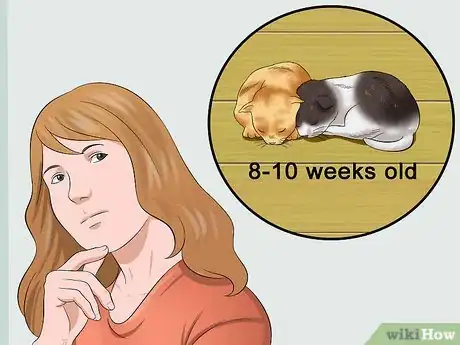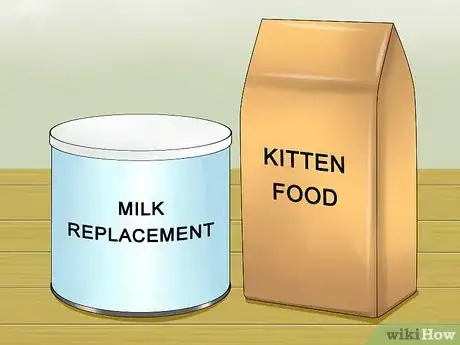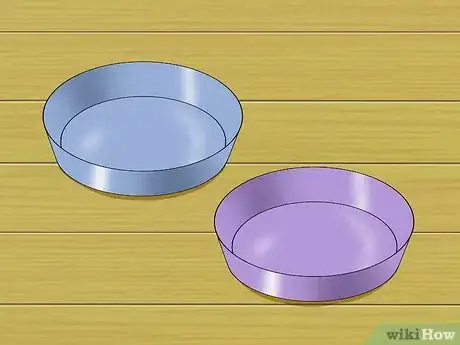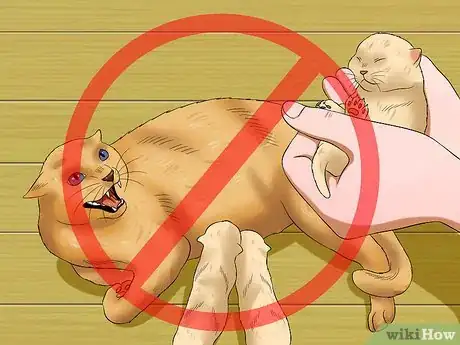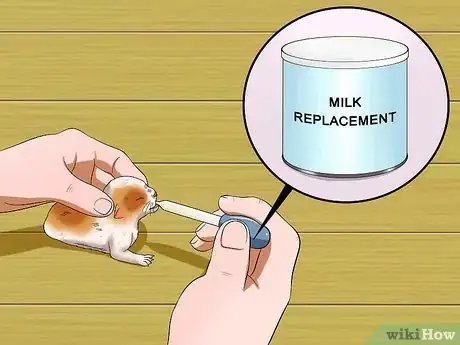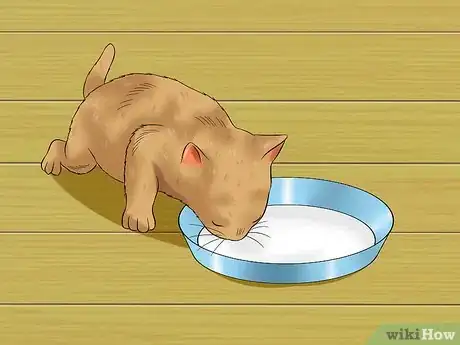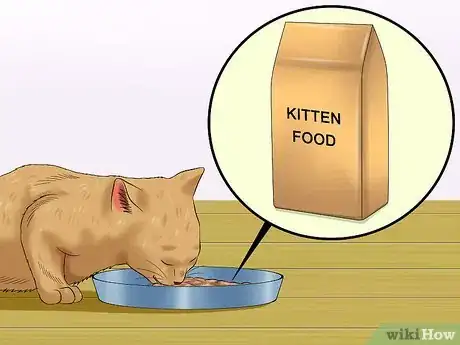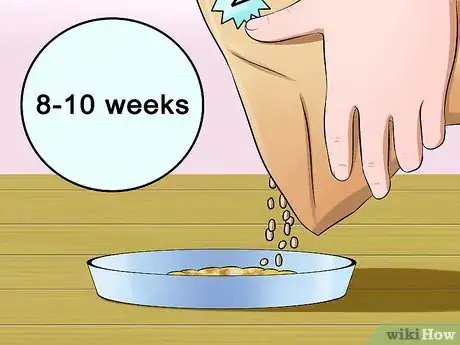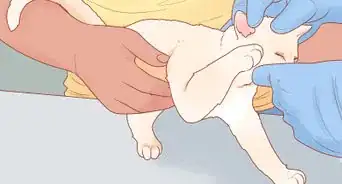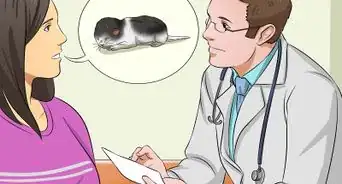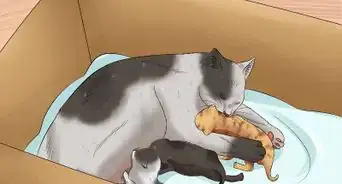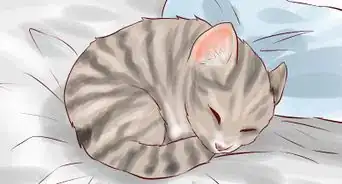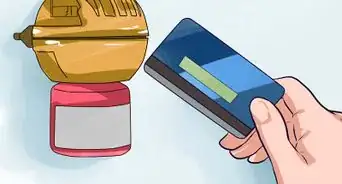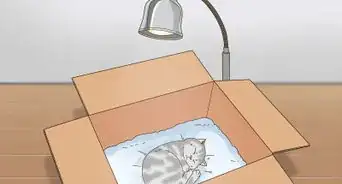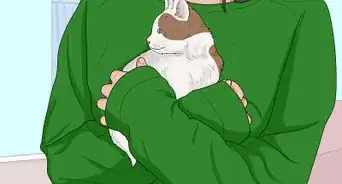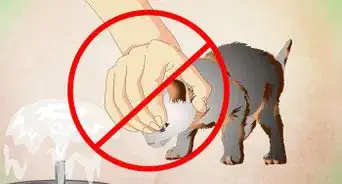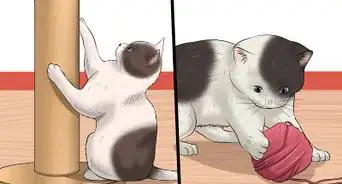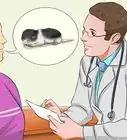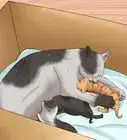This article was co-authored by Pippa Elliott, MRCVS. Dr. Elliott, BVMS, MRCVS is a veterinarian with over 30 years of experience in veterinary surgery and companion animal practice. She graduated from the University of Glasgow in 1987 with a degree in veterinary medicine and surgery. She has worked at the same animal clinic in her hometown for over 20 years.
There are 7 references cited in this article, which can be found at the bottom of the page.
wikiHow marks an article as reader-approved once it receives enough positive feedback. This article received 21 testimonials and 89% of readers who voted found it helpful, earning it our reader-approved status.
This article has been viewed 301,386 times.
Like most mammals, kittens begin life by consuming their mother's milk. The transition from their mother's milk to eating independently is called weaning. If your cat has had kittens or you are responsible for an orphan kitten, you need to know what to provide and what to do so that the kitten can make this vital step.
Steps
Preparing to Wean a Kitten
-
1Determine when to wean your kitten. The weaning process begins when kittens are around four weeks old. For most kittens, this process is usually completed when they reach eight to ten weeks old. Once a kitten has opened its eyes, is able to focus, and can walk steadily, you can begin the process.[1]
- At around 10 - 14 days, a kitten's eyes and ears start to open. Between 2 -3 weeks they start to stand and take wobbly steps, building up their muscles, and learning to walk. During this time, they still get all their nutrition from mother's milk. Once a mother sees that their kitten is mobile, they'll begin the weaning process themselves in the wild.
-
2Purchase the necessary nourishment. When you first start weaning your kitten off of its mother's milk, you'll want to buy milk replacer. It is designed to replicate the nutritional value and to a degree the taste of its mother's milk. You'll also want to be sure to purchase high-quality cat food, which will be introduced to the kitten gradually. A good rule of thumb is to see if a meat is listed first on its ingredients. This will mean that the food has a higher percentage of protein, which growing cats need to be healthy.[2]
- Do not give your kitten cow's milk. This is not a suitable replacement because your kitten's stomach cannot process it. The kitten will end up with diarrhea.[3]
Advertisement -
3Buy a shallow food and water dish. Ceramic or plastic bowls work equally well. Make sure that your kitten can easily reach the bottom of the bowl. Your kitten will take to its milk replacer and other foods much easier if it can lap its food up easily.[4]
-
4Do not abruptly remove your kitten from its mother if you can. Kittens, like children, learn through observation. Your kitten will observe its mother eating, using the litter box, and playing. It will then replicate much of this behavior. If you have both the mother and her kitten, try to keep them together as long as possible - or at least until the 10 weeks mark. They will naturally separate over time.
- It is ok to separate them for a few hours a day at around four weeks. Make sure that they have their own litter box and food/water bowls. Eventually, your kitten will become more independent and will willingly chose to be away from its mother.[5]
- Do not worry if your kitten has been orphaned. Your kitten has strong instincts when it comes to self-preservation. It will figure out a way to feed itself, even if its mother is not present. Most people that raise orphaned kittens choose to wean them onto solid food early, at around four weeks or so. At this point the kitten's stomach has developed to the point that it can process solid food. It just needs to be taught to eat solid food.[6]
Weaning Your Kitten
-
1Present your kitten with replacement milk. At first, your kitten will need about four to five meals a day. Give them around 1/3 cup of replacement milk and kitten chow for each meal.[7] They'll be fine to go through the night without a meal, but if you hear them making noise, it is ok to leave them some extra food before you go to bed.[8]
- If you have a newborn that's been removed from its mother, you'll need to replicate the suckling nature of its normal feeding time with an eye dropper. Fill the eye dropper with the replacement milk you've purchased. Hold the kitten securely and then slowly add a few drops of milk into the kitten's mouth at a time. Alternatively, some people dip their finger in the milk and let the kitten lick it off this way.[9]
-
2Acclimate the kitten to bowl feeding. This may be a difficult process for your kitten. If it is used to suckling milk from its mother, it will find the bowl a strange substitute. Simply show the kitten where the milk is. Dip your finger in the bowl and present it to the kitten. It will eventually recognize the scent and will explore it further.
- Refrain from pushing the head of the kitten into the bowl. Doing so could cause him to inhale the milk, which could lead to lung issues.[10] If the kitten is initially reluctant, return to dropper feeding or to his mother. However, begin every feeding by offering the bowl first to encourage the kitten to drink from the bowl.
-
3Introduce solid food. Once the kitten is accustomed to lapping from the bowl, offer a gruel mixture. To make a gruel, mix a ground high quality kitten food with the milk replacer. The initial consistency should be similar to oatmeal. Many people use a blender to mix their cat food with the milk replacer.[11]
- You can introduce your kitten to this gruel and other moist foods around five to six weeks.[12]
-
4Transition to solid food around eight to 10 weeks. Eventually stop providing gruel and, instead, offer well moistened kitten food. When you switch to the kitten food, make sure you provide a separate bowl of water for the animal.
- To complete the transition, moisten the kitten food less and less until it is accepted by the kitten in its original consistency. A bowl of water should always be available next to the food dish.[13]
- Make sure that your kitten has the opportunity to eat around four times a day until it is six months old. At this point, it is ok to transition them down to two meals a day.[14]
- Talk to your vet about feeding methods. Some vets promote the "ad lib" or "free feeding method" over the scheduled feeding routine. Proponents of ad lib feeding argue that it accommodates persnickety eaters - or those cats who won't eat at scheduled times. In general, if this seems to make your kitten/cat happier, it is ok. If your kitten turns into an overweight cat, you might consider going to a scheduled feeding schedule to limit the amount of food they consume a day.[15]
Expert Q&A
Did you know you can get expert answers for this article?
Unlock expert answers by supporting wikiHow
-
QuestionThe mother cat has been pinning the kittens down to try to make them drink. Her mammary glands are so full they feel hard. How can we make it easier on the mother?
 Pippa Elliott, MRCVSDr. Elliott, BVMS, MRCVS is a veterinarian with over 30 years of experience in veterinary surgery and companion animal practice. She graduated from the University of Glasgow in 1987 with a degree in veterinary medicine and surgery. She has worked at the same animal clinic in her hometown for over 20 years.
Pippa Elliott, MRCVSDr. Elliott, BVMS, MRCVS is a veterinarian with over 30 years of experience in veterinary surgery and companion animal practice. She graduated from the University of Glasgow in 1987 with a degree in veterinary medicine and surgery. She has worked at the same animal clinic in her hometown for over 20 years.
Veterinarian If the kittens are drinking less from her, then the mammary glands firm up as part of the process of the milk drying up. However, an infection in the mammary glands can also cause the glands to be hard, and this needs treatment. If the mother cat is unwell, not eating, or the mammary glands feel hot then she needs to the vet.
If the kittens are drinking less from her, then the mammary glands firm up as part of the process of the milk drying up. However, an infection in the mammary glands can also cause the glands to be hard, and this needs treatment. If the mother cat is unwell, not eating, or the mammary glands feel hot then she needs to the vet. -
QuestionAt what age does a kitten get their first shots?
 Pippa Elliott, MRCVSDr. Elliott, BVMS, MRCVS is a veterinarian with over 30 years of experience in veterinary surgery and companion animal practice. She graduated from the University of Glasgow in 1987 with a degree in veterinary medicine and surgery. She has worked at the same animal clinic in her hometown for over 20 years.
Pippa Elliott, MRCVSDr. Elliott, BVMS, MRCVS is a veterinarian with over 30 years of experience in veterinary surgery and companion animal practice. She graduated from the University of Glasgow in 1987 with a degree in veterinary medicine and surgery. She has worked at the same animal clinic in her hometown for over 20 years.
Veterinarian
Things You'll Need
- Kitten milk replacer
- High quality dry kitten food
References
- ↑ http://www.aspca.org/pet-care/cat-care/weaning
- ↑ http://www.aspca.org/pet-care/cat-care/weaning
- ↑ http://www.aspca.org/pet-care/cat-care/weaning
- ↑ Reproduction in the Dog and Cat. Christiansen, Publisher: Bailliere-Tindal
- ↑ http://www.aspca.org/pet-care/cat-care/weaning
- ↑ Hand Rearing Kittens. Bloomfield. Publisher: Able Publishing
- ↑ http://pets.webmd.com/cats/guide/feeding-your-kitten-food-and-treats
- ↑ https://www.pdsa.org.uk/taking-care-of-your-pet/the-keys-to-better-care/kittens-and-cats/diet
- ↑ http://www.aspca.org/pet-care/cat-care/weaning
- ↑ http://www.aspca.org/pet-care/cat-care/weaning
- ↑ http://www.peteducation.com/article.cfm?c=1+2139&aid=906
- ↑ http://www.aspca.org/pet-care/cat-care/weaning
- ↑ http://www.aspca.org/pet-care/cat-care/weaning
- ↑ https://www.pdsa.org.uk/taking-care-of-your-pet/the-keys-to-better-care/kittens-and-cats/diet
- ↑ https://www.aspca.org/pet-care/cat-care/feeding-your-adult-cat
About This Article
Before weaning your kitten, make sure that it’s around 4 weeks old, with the ability to focus and walk steadily. At that point, place ⅓ cup of milk replacer and kitten chow in a shallow bowl. Then, dip your finger in the food and present it to your kitten to encourage it to eat from the bowl. If your kitten is reluctant, try feeding it with an eye dropper, or by letting it lick the milk off your finger. However, begin each feeding by offering the bowl first to eventually acclimate your kitten to bowl feeding. For more advice from out Veterinary reviewer, including how to wean your kitten off the milk replacer, keep reading.
